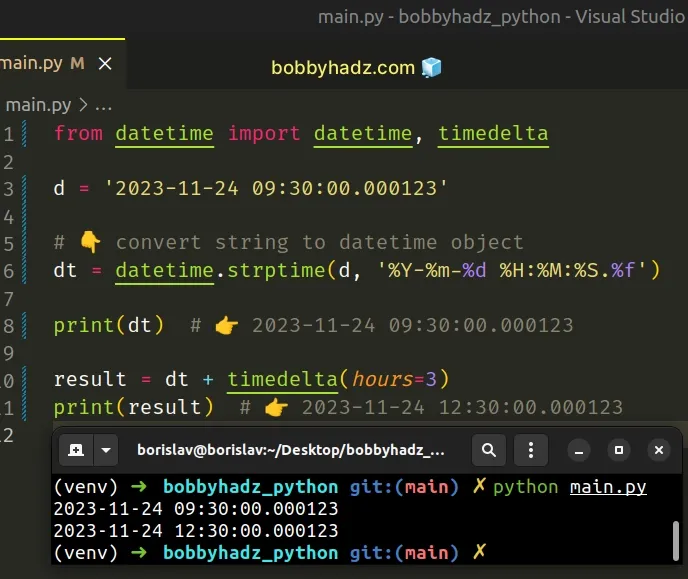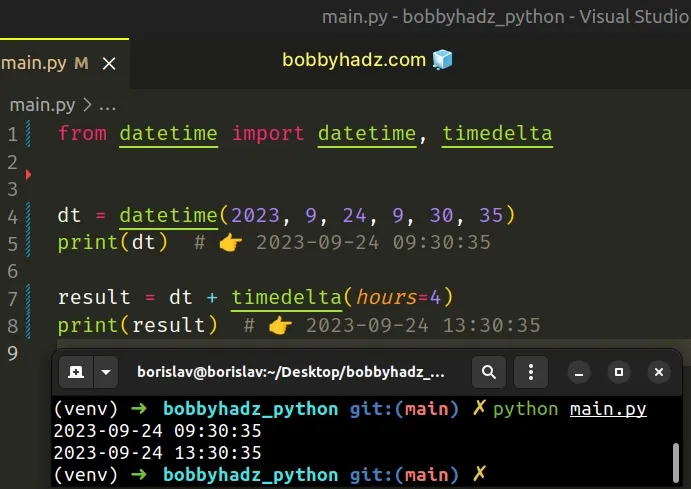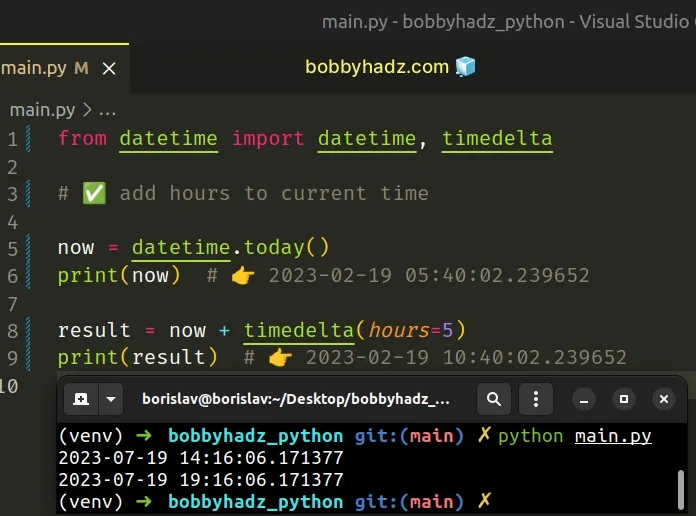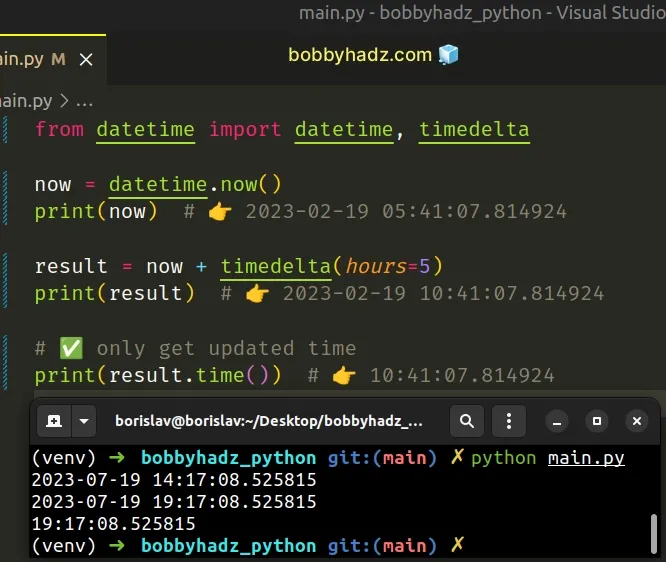How to add Hours to Datetime in Python
Last updated: Apr 8, 2024
Reading time·3 min

# Add hours to datetime in Python
Use the timedelta() class from the datetime module to add hours to
datetime, e.g. result = dt + timedelta(hours=10).
The timedelta class can be passed a hours argument and adds the specified
number of hours to the datetime.
from datetime import datetime, timedelta d = '2023-11-24 09:30:00.000123' # 👇️ convert string to datetime object dt = datetime.strptime(d, '%Y-%m-%d %H:%M:%S.%f') print(dt) # 👉️ 2023-11-24 09:30:00.000123 result = dt + timedelta(hours=3) print(result) # 👉️ 2023-11-24 12:30:00.000123

09:30:15 scroll down to the last code snippet.Make sure to import the datetime and
timedelta
classes from the datetime module.
The example creates a datetime object from a datetime string and adds hours
to it.
from datetime import datetime, timedelta d = '2023-11-24 09:30:00.000123' # 👇️ convert string to datetime object dt = datetime.strptime(d, '%Y-%m-%d %H:%M:%S.%f') print(dt) # 👉️ 2023-11-24 09:30:00.000123 result_1 = dt + timedelta(hours=3) print(result_1) # 👉️ 2023-11-24 12:30:00.000123
The datetime.strptime() method returns a datetime object that corresponds to the provided date string, parsed according to the format.
If you have a date string that is formatted in a different way, use
this table of the docs
to look up the format codes you should pass as the second argument to the
strptime() method.
# Using the datetime class to create a datetime object
The following example uses the
datetime
class to create a datetime object and the timedelta class to add hours to
it.
from datetime import datetime, timedelta dt = datetime(2023, 9, 24, 9, 30, 35) print(dt) # 👉️ 2023-09-24 09:30:35 result = dt + timedelta(hours=4) print(result) # 👉️ 2023-09-24 13:30:35

We passed values for the year, month, day, hour, minute and seconds
arguments.
# Adding hours to the current time
If you need to add hours to the current time, use the datetime.today() method
to get a datetime object that stores the current time.
from datetime import datetime, timedelta # ✅ Add hours to current time now = datetime.today() print(now) # 👉️ 2023-02-19 05:40:02.239652 result = now + timedelta(hours=5) print(result) # 👉️ 2023-02-19 10:40:02.239652

The datetime.today() method returns the current local datetime.
datetime object because it automatically rolls over the days, months and years if necessary.This wouldn't be possible if we only had the time component. For example,
11:59:30PM + 2 hours would raise an exception.
# Only extracting the time component after adding hours
If you only need to extract the time after the operation, call the time()
method on the datetime object.
from datetime import datetime, timedelta now = datetime.now() print(now) # 👉️ 2023-02-19 05:41:07.814924 result = now + timedelta(hours=5) print(result) # 👉️ 2023-02-19 10:41:07.814924 # ✅ Only get updated time print(result.time()) # 👉️ 10:41:07.814924

The datetime.time() method returns a time object with the same hour, minute, second and millisecond.
# Formatting the time as HH:MM:SS after adding hours
If you need to get the time formatted as HH:MM:SS, use a formatted string
literal.
from datetime import datetime, timedelta now = datetime.now() print(now) # 👉️ 2023-02-19 05:41:40.114944 result = now + timedelta(hours=3) print(result) # 👉️ 2023-02-19 08:41:40.114944 print(result.time()) # 👉️ 08:41:40.114944 # 👇️ format as HH:MM:SS print(f'{result:%H:%M:%S}') # 👉️ 08:41:40
Formatted string literals
(f-strings) let us include expressions inside of a string by prefixing the
string with f.
Make sure to wrap expressions in curly braces - {expression}.
Formatted string literals also enable us to use the format specification mini-language in expression blocks.
# Adding hours to a time using datetime.combine()
If you only have the time component, use the datetime.combine method to
combine the time with the current (or some other) date and get a datetime
object.
from datetime import datetime, date, timedelta, time t = time(6, 25) print(t) # 👉️ 06:25:00 result = datetime.combine(date.today(), t) + timedelta(hours=6) print(result) # 👉️ 2023-02-19 12:25:00 only_t = result.time() print(only_t) # 👉️ 12:25:00
The
datetime.combine()
method takes a date and time as arguments and returns a new datetime
object by combining them.
Once we get a datetime object, we can use the timedelta class to add hours
to it.
# Additional Resources
You can learn more about the related topics by checking out the following tutorials:
- How to add Days or Weeks to a Date in Python
- How to add Milliseconds to Datetime in Python
- How to add Minutes to Datetime in Python
- How to add Months to a Date in Python
- How to add Seconds to Datetime in Python
- How to Add year(s) to a date in Python
- Can't compare offset-naive and offset-aware datetimes [Fix]
- How to convert a datetime.timedelta to String in Python
- How to format datetime or time as AM/PM in Python

